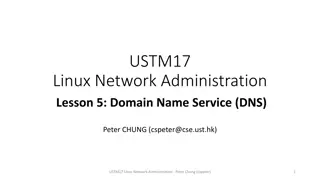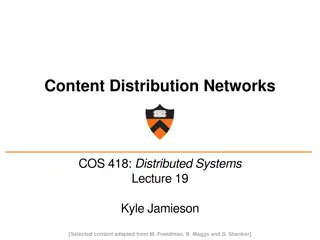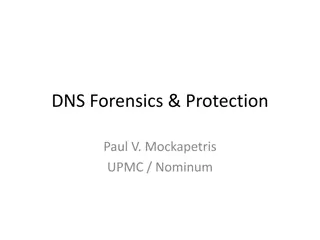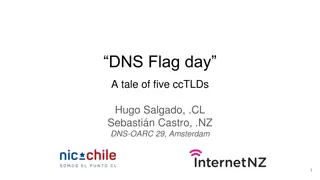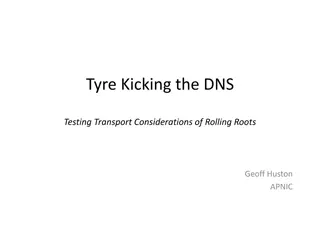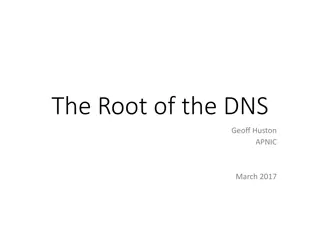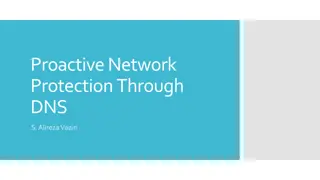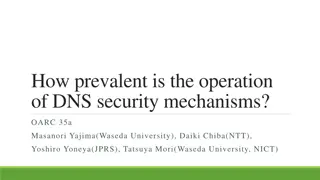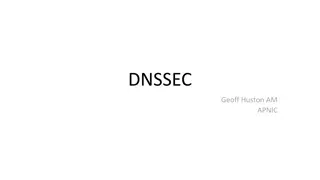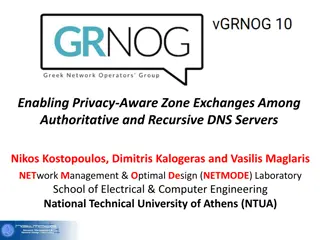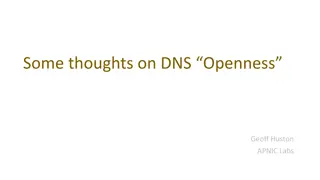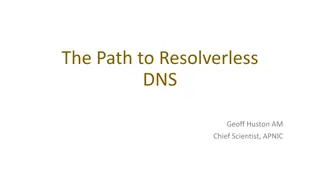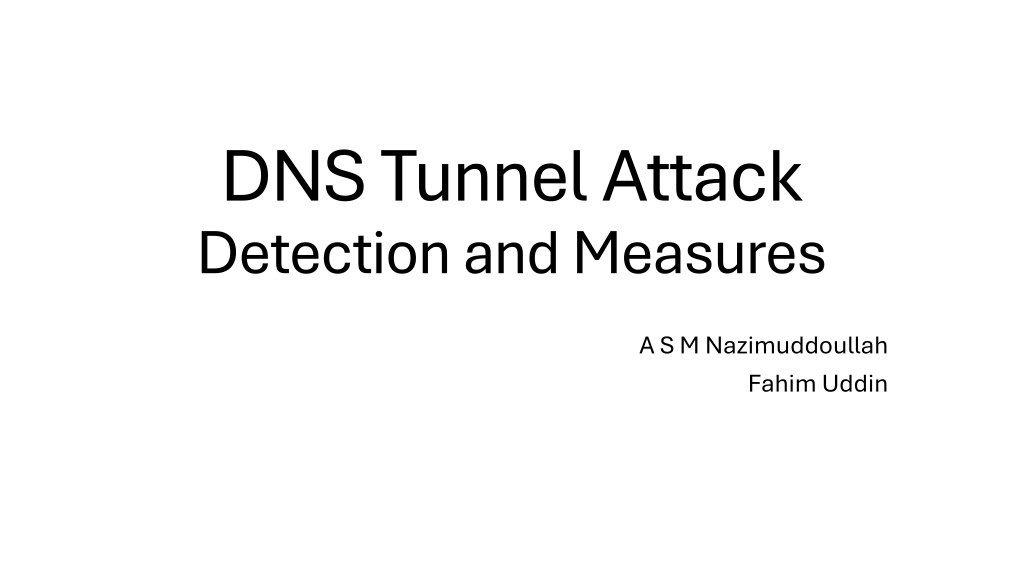
DNS Tunneling Detection and Measures
Learn about DNS tunneling attacks and how they work, including detection methods and preventive measures. Understand popular DNS record types and how the DNS tunneling process functions to create a communication channel for malicious activities.
Download Presentation

Please find below an Image/Link to download the presentation.
The content on the website is provided AS IS for your information and personal use only. It may not be sold, licensed, or shared on other websites without obtaining consent from the author. If you encounter any issues during the download, it is possible that the publisher has removed the file from their server.
You are allowed to download the files provided on this website for personal or commercial use, subject to the condition that they are used lawfully. All files are the property of their respective owners.
The content on the website is provided AS IS for your information and personal use only. It may not be sold, licensed, or shared on other websites without obtaining consent from the author.
E N D
Presentation Transcript
DNS Tunnel Attack Detection and Measures A S M Nazimuddoullah Fahim Uddin
DNS Domain hostname with IP address Described in RFC1034 and RFC1035 Name System (DNS) translates human readable www.xyz.com 1.2.3.4 Client Local DNS
DNS Local DNS server will do iterative query(step 2-7) if answer not available 2 Root Name server 3 1 4 5 8 Top Level Name server Client Local DNS 6 7 Authoritative Name server https://datatracker.ietf.org/doc/html/rfc1035
Popular DNS Record Types Record Type A AAAA CNAME NS MX NAPRT PTR SOA TXT Type ID 1 28 5 2 15 35 12 6 16 Function Translates 32-bit IPv4 address Translates 128-bit IPv6 address Alias of one name to another Name record server List of mail exchange servers Naming authority pointer Pointer to a CNAME Start of zone authority record Human readable text in DNS record https://en.wikipedia.org/wiki/List_of_DNS_record_types
DNS Tunneling Creating a tunnel in client-server model using DNS protocol Mostly used for malpractice Encapsulates the data in the DNS query and DNS response packet Create a tunnel between sender and receiver through DNS protocol Use DNS requests to implement a command and control (C2) channel for malware https://www.sciencedirect.com/science/article/pii/S1389128621003248
How DNS Tunnel works https://www.sciencedirect.com/science/article/pii/S1389128621003248
How DNS Tunnel works (Cont.) Attacker registers a domain (example: maldomain.com) Domain s name server points to the attacker s server installed with a tunneling malware program Attacker infects targeted computer with malware Infected computer can send a query to the local DNS server just like regular DNS query Local DNS relays requests for IP addresses to root and top-level domain servers (recall iterative DNS) The C2 server reply several command control instructions as response back to the local name server inside DNS answer https://www.paloaltonetworks.com/cyberpedia/what-is-dns-tunneling
How DNS Tunnel works (Cont.) Local DNS send the computer(victim) with the attacker s C2 (command-and-control) message, where the tunneling program is installed A connection (tunnel) is now established between the victim and the attacker Inbound DNS traffic can carry commands to the malware, while outbound traffic can exfiltrate sensitive data The subdomain name in DNS packets can be used to encapsulate upstream data https://www.paloaltonetworks.com/cyberpedia/what-is-dns-tunneling
Purpose of DNS Tunnel DNS protocol is widely used and trusted Usually, organizations allow DNS traffic to pass through the firewall Legitimate purposes to bypass the firewall in restricted environment. Availability of DNS tunneling toolkits for malicious actor Mostly used by attackers to exfiltrate data or establish hidden communication channels https://www.akamai.com/glossary/what-is-dns-tunneling
Motivations for DNS tunneling attack DNS tunneling is a secret method used by attackers to hide malicious activity within apparently normal DNS traffic like the following: Command and control (C2) communication: Malware can bypass firewalls and other security measures to establish C2 communication with remote servers. Data Exfiltration: Sensitive information can be leaked using DNS queries. Botnet control: Attackers can create networks of affected devices (botnets) using DNS tunneling to open attacks or perform other malicious activities. Avoiding censorship: DNS tunneling can be used to bypass internet restrictions and access harmful blocked content. https://blogs.blackberry.com/en/2023/03/dns-tunneling-guide-to-detection-and-prevention
Actors for DNS tunneling attack Cybercriminals: For executing attacks like ransomware, data theft, fraud, etc. State-sponsored attackers: DNS tunneling for intelligence or warfare. Hacktivists: Motivated by political or ideological causes. DNS tunneling creates a considerable threat due to its secret nature. https://www.scworld.com/brief/threat-actors-expanding-malicious-use-of-dns-tunneling
DNS Tunnel Tools IP over a DNS tunnel: encapsulates IP packets in the DNS tunnel Example: NSTX, Dnscat2, Iodine, and TUNs TCP over a DNS tunnel: encapsulates TCP packets in the DNS tunnel Example: Dns2tcp, OzymanDns, Heyoka https://www.sciencedirect.com/science/article/pii/S1389128621003248
Features of DNS Tunnel Payload analysis to analyze the content of DNS packet (Real-time) Size of packet (uplink usually bigger in exfiltration) Upload-download ratio (upload is extensive) Length of domain name and number of subdomains (Checking if each label in a domain is larger than 63 bytes which will also increase subdomain numbers) Special characters or meaningful words in the domain name Unusual subdomain names Uncommon record type Searching for specific DNS tunnel tool s signature and policy violation in directly connected DNS tunnel https://www.sciencedirect.com/science/article/pii/S1389128621003248
Features of DNS Tunnel (Cont.) Flow analysis to analyze the overall DNS traffic (Not real-time) Volume of DNS traffic (Average traffic be unusual and larger than 512 bytes for some IP addresses each also unusual DNS traffic to a particular domain) Volume of hostnames to the domain name Longer time interval due to disguised server Geographic location of DNS server Isolated DNS queries (No other consequent traffic) Volume of response type (other than successful) DNS traffic visualization https://www.sciencedirect.com/science/article/pii/S1389128621003248
Detection Mechanism of DNS Tunnel [1] DNS Tunnel Detection Model-Based Rule-Based Signature Threshold Deep-Learning Traditional Supervised Unsupervised Traffic Payload https://www.sciencedirect.com/science/article/pii/S1389128621003248
Detection Mechanism of DNS Tunnel Rule-Based detection (Setting manual preset rules to target specific features). Can be achieved by: IDS or IPS solution Big data search components (Splunk) Firewalls (PaloAlto) https://www.sciencedirect.com/science/article/pii/S1389128621003248
Detection Mechanism of DNS Tunnel (Cont.) A. Signature-Based methods (Rule-Based) By deep packet inspection of DNS header and payload to find specific signature Not fruitful for new pattern/signature and high resource consumption B. Threshold-Based methods (Rule-Based) Payload-based threshold quantitively analysis of several packets to find for domain related features like length, character frequency etc. Although difficult to implement but performance is good. Traffic-based threshold analysis focus on entire traffic-related features thus it can detect both known and unknown based on abnormal behaviors of DNS tunneling tools. https://www.sciencedirect.com/science/article/pii/S1389128621003248
Detection Mechanism of DNS Tunnel (Cont.) Model-Based detection (Built on the training of machine learning model) Use different machine learning algorithms for both traditional and deep learning. A. Traditional Machine Learning-Based methods ( Model-Based ) a) Unsupervised Learning [1]: In DNS tunnel detection, the most popular K- means algorithm has a low true-positive rate; however, for data leak activity, the logistic regression algorithm with statistical feature subdomains is used, which has higher high-level accuracy. The k-means model performed poorly when random starting points were used, suggesting that it might not be helpful for identifying odd samples. The small and somewhat unbalanced dataset generated by just four clients may be the reason for this, as it may lack sufficient details to accurately identify malicious DNS traffic. https://www.sciencedirect.com/science/article/pii/S1389128621003248
Detection Mechanism of DNS Tunnel (Cont.) b) Supervised Learning[1]: The most popular algorithm is the support vector machine (SVM) for DNS tunnel detection. The SVM algorithm is better than Bayes, logistic regression, decision trees, and other algorithms in performance. Additionally, the linear SVM is not as effective as the SVM based on kernel functions. While k-means is commonly utilized in unsupervised learning, it is less effective than unsupervised SVM in a mobile network setting. https://www.sciencedirect.com/science/article/pii/S1389128621003248
Detection Mechanism of DNS Tunnel (Cont.) Model-Based detection by Deep Learning-Based Detection methods (Less used though) Mostly supervised learning The convolutional neural network (CNN) is the most popular deep learning algorithm for DNS tunnel detection. It can use sequential and structural information to extract features automatically to analyze the whole data to find any anomaly in DNS. It is not commonly used as it needs costly hardware and large data sets to train the model. https://www.sciencedirect.com/science/article/pii/S1389128621003248
Additive measure for DNS Tunnel Detection More steps can be taken to consider the following two aspects in addition to DNS tunnel detection A. Importance of detecting heartbeat traffic in DNS tunnels Properly detecting the heartbeat traffic in DNS tunnels can save the system before any malicious activities take place. It also improves the performance of DNS tunnel detection by early determining the inactive DNS tunnel. B. All protocols that use encapsulation in DNS tunnels If protocols such as FTP, HTTP, SMTP, SSH, etc., are encapsulated in the DNS tunnel, it will make detection more difficult. Further research is needed to address the challenges of detecting DNS tunnels that use encapsulation. https://www.sciencedirect.com/science/article/pii/S1389128621003248
Challenges of DNS Tunnel Detection DNS over TLS (DoT) and DNS over HTTPS (DoH) are making DNS tunnel detection more difficult: These new protocols use TLS or HTTPS encryption to protect DNS traffic during transmission. This creates double encryption, which results in double tunneling and creates challenges for DNS tunnel detection. Further research ongoing to address the challenges related with such scenario. https://www.sciencedirect.com/science/article/pii/S1389128621003248
Future Proof of DNS Tunnel Regularly Monitor DNS Traffic: Search for unusual patterns, such as high volumes of queries, large text strings, or queries to unusual domains. Robust Firewall Rules and Traffic Analysis: Implement strong firewall rules and conduct thorough traffic analysis. HAR file analysis can also be a great approach https://www.sciencedirect.com/science/article/pii/S1389128621003248
Future Proof of DNS Tunnel Limit Unnecessary DNS Queries: Specially record types TXT, NULL, SRV, etc. Blocking domain names, IP addresses, or geolocation based on their known reputation or vulnerability. Properly configuring DNS security extensions (DNSSEC) during the authentication of DNS data. https://www.sciencedirect.com/science/article/pii/S1389128621003248
References 1. A comprehensive survey on DNS tunnel detection https://www.sciencedirect.com/science/article/pii/S1389128621003248 2. Malicious DNS Tunneling Detection in Real-Traffic DNS Data https://ieeexplore.ieee.org/abstract/document/9378418/authors#authors 3. https://www.paloaltonetworks.com/cyberpedia/what-is-dns-tunneling 4. https://datatracker.ietf.org/doc/html/rfc1034 5. https://datatracker.ietf.org/doc/html/rfc1035 6. https://www.checkpoint.com/cyber-hub/network-security/what-is-dns- tunneling/ 7. https://www.akamai.com/glossary/what-is-dns-tunneling 8. https://en.wikipedia.org/wiki/List_of_DNS_record_types 9. https://unit42.paloaltonetworks.com/dns-tunneling-how-dns-can-be-abused- by-malicious-actors/ 10. https://blogs.blackberry.com/en/2023/03/dns-tunneling-guide-to-detection- and-prevention 11. https://www.scworld.com/brief/threat-actors-expanding-malicious-use-of- dns-tunneling



